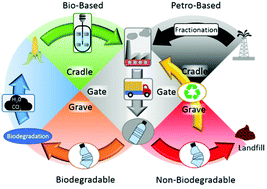Review of recent advances in the biodegradability of polyhydroxyalkanoate (PHA) bioplastics and their composites
Abstract
The detrimental impact of single-use plastics on the environment is daily news across the globe. Single-use plastic packaging materials and other plastic waste originating from petroleum-based sources are continuously building up in landfills and leaching into the environment. Managing plastic waste remains an urgent crisis in the environment and switching to biodegradable plastics can help mitigate some of these issues. This review will summarize recent advances and opportunities to utilize polyhydroxyalkanoates (PHAs) as a biodegradable substitute in some applications where non-biodegradable and petroleum-based plastics are currently used. PHAs are a well-known family of bacteria-based biodegradable plastics and offer an approach to carbon neutrality and support a more sustainable industry. PHAs such as poly(3-hydroxybutyrate) (PHB) and poly(3-hydroxybutyrate-co-3-hydroxyvalerate) (PHBV) show biodegradable behaviour in all aerobic and anaerobic environments defined by ASTM standards, and can be used to make completely compostable, and soil and marine biodegradable products – a strong positive compared to the negativity associated with the landfilling of plastics. However, PHAs are relatively expensive compared to petroleum-based alternatives. To reduce the cost, PHAs can be used in biocomposite materials, where bio-based agro-residues are incorporated, while maintaining the performance in certain applications. Organic fillers and fibres composed of cellulosic material can improve the properties of polymers, however, their effect on the marine biodegradable properties of the composite matrix remains an unexplored area. When used in biocomposites with PHAs, they improve biodegradation rates in all environments. In addition to cellulose, other bio-based fillers such as proteins (i.e. distillers dried grains with solubles) and starch have been reported to significantly improve soil and marine biodegradability rates compared to other fibres and fillers. Other components that affect biodegradability are additives (i.e. chain extenders) and compatibilizers (i.e. maleic anhydride etc.) that are added to optimize the service life properties, but are reported to inhibit the biodegradation properties by impacting the hydrophilicity of the polymer and enzyme activity. The multitude of possible combinations of polymers and fillers and fibres, and their effect on the biodegradation of PHA-based biocomposites are a largely unexplored frontier. The potential benefits of PHA-based biocomposites make a strong case for further research into this area.



 Please wait while we load your content...
Please wait while we load your content...